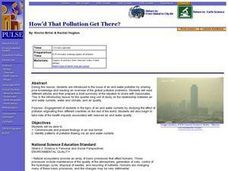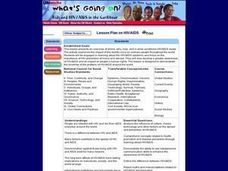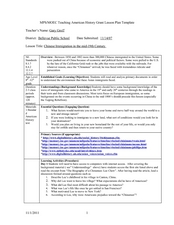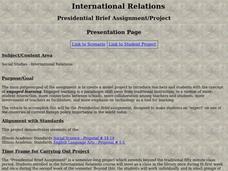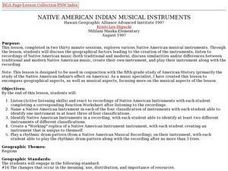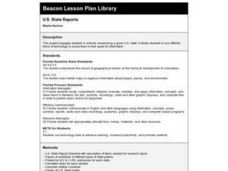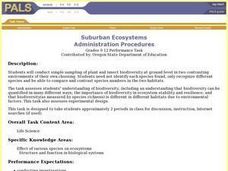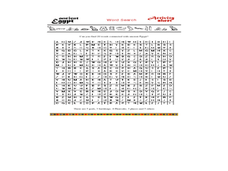Curated OER
Environment: How'd That Pollution Get There?
Learners examine how global wind and water patterns aid in the spread of worldwide pollution. In groups, they read articles about the domino effect of pollution and create posters displaying its journey. On blank world maps, students...
Curated OER
Lesson Plan on HIV/AIDS
Students examine where, why, how and in what conditions HIV/AIDS exists. They examine the deadly impact this virus has had on the world and look at how to prevent the spread at home. The students also develop a greater awareness of the...
Curated OER
The Human Pendulum
Students explore the pendulum. In this physics lesson, students investigate how length, amplitude and mass affect the period of a pendulum. The students will engage in an exploratory activity in order to best grasp the concepts of motion...
Curated OER
Habitat survival
Sixth graders study different environments and how the food chain affects the survival of different animals. In this environments lesson plan, 6th graders share the visuals which describe the characteristics of the environment that they...
Curated OER
Chinese Immigration in the Mid-19th Century
Students interpret historical evidence presented in primary and secondary resources. In this Chinese immigration instructional activity, students research the Chinese immigration between 1850 and 1882.
Curated OER
Religious Revival: The American Response to the Cold War
Learners examine the impact of religion on the Cold War. In this Cold War lesson, students analyze speeches delivered by Lenin, Truman, and Graham regarding the role of religion in society. As a culminating activity, learners are tested...
Curated OER
Source Search
Pupils discuss the sources of items they use everyday. For this social studies lesson, students sort pictures of items used everyday by their source. Pupils participate in a source relay.
Curated OER
The Tadpole and the Frog
First graders examine the life cycle of the frog, and research frogs of the Nez Perce reservation and their requirements for survival. They observe the development of frog eggs and record their observations in science journals.
Curated OER
International Relations
Ninth graders are expected to have an in-depth understanding of a country's national profile, current events, and projected foreign policy options and the impact of those options on current world affairs.
Michigan Sea Grant
Water Quality
Learners observe water samples and measure the samples' water quality. Students develop their own criteria for measuring water quality and test for temperature, acidity, oxygen levels, turbidity, conductance, sediment and hardness.
Curated OER
Japan's Place In The World
Students conduct research into the history of th Japanese rise to economic power. They use a variety of sources for information and engage in a variety of in class and out of class activities.
Curated OER
The Law of Inertia
Students practice the 4 question strategy to form more questions and develop further experiments. The four questions are engage, explore, explain, and elaborate. They use the 4 question strategy on an investigation involving the mass...
Curated OER
The Inventions and Effects of the Industrial Revolution
Students understand that the Industrial Revolution began in England, spreading to the rest of Western Europe and the United States and with it came an increased demand for raw materials from the Americans, Asia, and Africa.
Curated OER
Creek Restoration Project
Students gather and analyze scientific data from a local creek. Over weeks or months, students observe their local environment, collect water samples, and evaluate test results. Extension activities are suggested for evaluating...
Curated OER
Native American Indian Musical Instruments
Learners listen and react to recordings of Native American Instruments with each student completing a corresponding Reaction Worksheet after listening to the recordings.
Curated OER
U.S. State Reports
Pupils conduct Internet research on a chosen U.S. state. They include information about the history, climate, geography, symbols, and tourist attractions of their state, and write an original poem.
Curated OER
Preserving and Promoting Democracy
Eleventh graders create surveys to determine whether or not young people have or plan to vote. Using their findings, 11th graders make advertisements aimed at encouraging youth to vote.
Curated OER
Looking at Teachers Among Us: A Workshop in Conceptions of Teaching
Students characterize various traditional conceptions of teaching and apply these to authentic teaching situations. Teaching art, math and grading systems are analyzed in this lesson.
Curated OER
Acting Out
Sixth graders investigate peer pressure, gangs, drinking, and using drugs. In small groups, they conduct research, develop, edit, and write a three-minute script, and perform the script for the class.
Curated OER
Trade -- Lesson Plan on the Theory of Comparative Advantage
Twelfth graders examine the theory of comparative advantage. They read an article about globalization and trading to answer questions promoted by the teacher. They develop their own examples of comparative advantage.
Curated OER
Ecoregions of Texas
Students map the ecoregions in Texas and illustrate the vegetation native to the region. They will use their maps to investigate why prehistoric hunter-gatherers might have decided to live in one area over another, such as the ancient...
Curated OER
Suburban Ecosystems
Learners conduct simple sampling of plant and insect biodiversity at ground level in two contrasting environments of their own choosing. They recognize and record different species then compare and contrast species numbers in the two...
Curated OER
The Nutritional Content of Food
Students are given three unknown samples and must perform two chemical tests in order to determine if the samples contains protein and/or starch. Students work with corrosive or toxic reagents.
Curated OER
Social Studies: Ancient Egypt
Seventh graders explore the history, geography, and culture of ancient Egypt. They research daily life and compare it with their present lives. Students, in pairs, trace their body outlines on poster paper and work individually to use...


